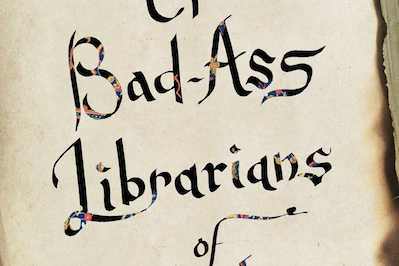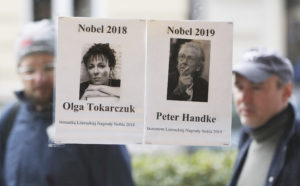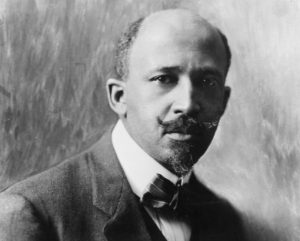The Bad-Ass Librarians of Timbuktu
Although the title is deceiving for those expecting the fast-paced heroics of James Bond, the reader will find that this account of a small group of ordinary people risking their lives to preserve their culture is an even more rewarding and essential story.
Simon & Schuster
“The Bad-Ass Librarians of Timbuktu: And Their Race to Save the World’s Most Precious Manuscripts”
A book by Joshua Hammer
“You can wipe out a generation of people, burn their homes to the ground and somehow they’ll still come back. But if you destroy their achievements and their history, it’s as if they never existed.”
Although this quote from the film “The Monuments Men” refers to the Nazis’ confiscation and burning of Jewish artwork during World War II, it can easily be applied to ISIS’ destruction of Palmyra’s 2,000-year-old temples in 2015 or the near eradication of thousands of ancient Islamic manuscripts in Timbuktu by al-Qaida in 2013.
 The Bad-Ass Librarians of Timbuktu: And Their Race to Save the World’s Most Precious Manuscripts
Purchase in the Truthdig Bazaar
The Bad-Ass Librarians of Timbuktu: And Their Race to Save the World’s Most Precious Manuscripts
Purchase in the Truthdig Bazaar
The valiant efforts of an unassuming group of librarians risking their lives in a brazen heist to protect priceless Arabic texts from Islamic extremists is chronicled in the book with the cheeky title “The Bad-Ass Librarians of Timbuktu.” Author Josh Hammer, a former Newsweek bureau chief and foreign correspondent, meticulously details the bare-bones, clandestine operation along with the rich and often complex history and conflicts of the West African country of Mali and the legendary city of Timbuktu.
The gripping tale is revealing, illuminating Timbuktu’s little known cultural, literary and artistic legacy, while also exploring the rise of the jihadists who wanted that legacy destroyed.
In spring 2012, Islamic militants associated with al-Qaida seized control of Timbuktu. Fearing an immediate threat to the precious manuscripts stored in the city’s libraries, a team of librarians initiated a covert plan to smuggle thousands of carefully preserved documents out of the libraries to safety.
Limited to only two hours a night before curfew, exhibition cases and archives would be emptied of the texts, then jam-packed into approximately 2,500 metal footlockers. Under the cloak of darkness, the padlocked chests were wrapped in blankets, loaded onto mule carts, and delivered to designated safe houses around town. The mission was so secret the fearless leader of the operation, Abdel Kader Haidara, told no one, not even his own family.
To fully understand the urgency of the situation, it’s essential to comprehend the rich history of Timbuktu and the significance of the manuscripts, some dating back to the early 16th century.
During the Songhai Empire (1468 – 1591) Timbuktu reached its political and intellectual “Golden Era.” Intellectual activity flourished, the city abounding with great scholars and universities. Their teachings and writings covered science, medicine, history, philosophy, literature and more. There were technical surveys of math and astronomy. Timbuktu had also practiced the teachings of Islam for 1,000 years.
When Moroccan forces invaded in 1591, manuscripts were destroyed, or split up and scattered among families. Many were hidden in caves or buried in sand.
Although the book’s title sounds like an “Indiana Jones” sequel, the protagonist is not a suave, adventurous archeologist but rather a mild mannered librarian and his motley crew clothed in modest, long robes. How they carefully orchestrated a secret operation under the vigilant eyes of Islamic police patrols is a feat worthy of any movie caper.
Most readers will understand the severe repercussions of being discovered by al-Qaida: torture, beheadings and destruction of the centuries-old manuscripts.
The responsibility of saving the cultural treasures fell reluctantly on Haidara, the son of Mamma Haidara, a prominent scholar and the namesake of The Mamma Haidara Library, which housed one of the oldest and largest private manuscript collections in Timbuktu.
After his father’s death in 1981, the job of collecting and restoring Timbuktu’s texts was thrust upon Haidara, who initially resisted. Mahmoud Zouber, director of the Ahmed Baba Institute, a government-run library in Timbuktu, eventually persuaded him of his duty to tradition.
Haidara was tasked with tracking down and acquiring as many ancient manuscripts as possible. This involved convincing wary villagers that he was not stealing their family heirlooms but preserving them in libraries. It was a herculean undertaking that lasted nine years. Hammer, who interviewed Haidara on several occasions, writes of the librarian’s excruciatingly long treks across the searing desert in camel caravans, surviving road accidents and navigating the rough waters of the Niger River. In the end, he acquired 16,500 manuscripts.
Many were lost due to improper storage. One collection, languishing in an old chest for 20 years, was finally opened to yield termite infestation, leaving nothing but shreds and dust. Others had brittle bindings, and yellowed and moldy pages.
Despite setbacks, Haidara managed to procure a few treasures, including a text dating to A.D. 991 by medieval Songhai writer, scholar and political provocateur Ahmed Baba, and an 11th century Quran written in Egypt.
With eventual funding and grants from UNESCO and the Ford and Mellon foundations, the library thrived. Haidara was soon able to build a state of the art facility, hire and train staff to properly scan, digitize, preserve and catalog the manuscripts. They held symposiums and exhibited a selection of manuscripts at the Library of Congress in 2003. In 2000, he built The Mamma Haidara Commemorative Library.
Just five years earlier, in 1995, Timbuktu was a two-phone-line town. But around the time that the Haidara library was built, the city experienced a second cultural renaissance, with tourism thriving, supported by five hotels, internet cafes and the annual Festival in the Desert, which attracted the likes of U2’s Bono. Researchers and preservationists traveled from afar to examine the Haidara manuscripts.As the library collections grew and expanded, so did Islamic terrorist organizations across the Middle East and North Africa. Kidnappings and beheadings of Western hostages began to escalate. Hammer explains how multimillion-dollar ransoms paid by several countries—$6.4 million from Austria and an estimated $12.7 million from the Spanish government in 2010 for three aid workers—unwittingly provided the money to fuel the jihadist movement.
The real trouble in Mali can be traced to the Arab Spring in 2011. After the fall of Libyan dictator Moammar Gadhafi, Mali’s Turag radicals plundered Libyan arsenals. Weapons were stockpiled in order to defeat Mali’s army. Soon after, the rebels created a new militia, Ansar Dine. To gain control of the country, they aligned with al-Qaida in the Islamic Magreb (AQIM).
As they stormed their way through Mali, Ansar Dine rebels arrested unmarried men and women seen in public together. One couple was buried up to their necks and stoned to death for having a child out of wedlock. Amputations and whippings were ordered for breaking the law.
In 2012 the rebels seized control of Timbuktu and soon implemented their strict form of Shariah law. Cafes were drained of alcohol. Radio stations were turned into 24-hour Quran readings. Even soccer matches on TV were banned. “Boys should be praying, not playing in the streets,” announced one militant.
Hammer’s authoritative voice on the region and the development of radical Islam provides necessary context to the story. His occasional meandering into flowery, travelogue territory can feel a bit disconnected against the backdrop of extreme violence. Some chapters and timelines jumped around so much I had to flip back and forth, rereading passages of common names, dates and mergers of terrorist organizations.
What the militants considered “offensive” material in the manuscripts, worthy of being wiped from the pages of history, is revealing. Several manuscripts contradicted Western stereotypes of Islam as a religion of intolerance — they denounced slavery, and urged moderation and acceptance of Jews and Christians. Other writings disputed modern Shariah law. One text titled “Advising Men on Sexual engagement with Their Women,” unabashedly provides infertility remedies.
When Haidara learned of the destruction of ancient Sufi shrines and tombs in July 2012, he feared the manuscripts would be next.
Despite assurances from the occupiers that the manuscripts would be safe, Haidara knew they would eventually view the ancient texts as un-Islamic and ripe for pillaging. Phase two of the operation was quickly set in motion.
A trusted network of confidants smuggled the delicate manuscripts from safe houses out of Timbuktu via the Niger River in pinasse boats, eventually making their way to the capital city of Bamako, a 15-hour drive south.
Hammer’s book sheds light on one of many aspects of the war on terror. Although the title is deceiving for those expecting the fast-paced heroics of James Bond, the reader will find that the story of a small group of ordinary people risking their lives to preserve their culture is an even more rewarding and essential tale.
In the end, Haidara and his team of librarians, couriers and locals rescued an estimated 500,000 manuscripts from 45 libraries over 18 months from one of the most treacherous enemies in the world. Now, that’s badass.
Independent journalism is under threat and overshadowed by heavily funded mainstream media.
You can help level the playing field. Become a member.
Your tax-deductible contribution keeps us digging beneath the headlines to give you thought-provoking, investigative reporting and analysis that unearths what's really happening- without compromise.
Give today to support our courageous, independent journalists.






You need to be a supporter to comment.
There are currently no responses to this article.
Be the first to respond.